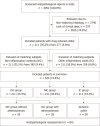Triggers of histologically suspected drug-induced colitis
- PMID: 30833802
- PMCID: PMC6397729
- DOI: 10.3748/wjg.v25.i8.967
Triggers of histologically suspected drug-induced colitis
Abstract
Background: Drug toxicity is a common and even serious problem in the gastrointestinal tract that is thought to be caused by a broad spectrum of agents. Although withdrawal of the causative agent would cure the disease knowledge is scarce and mostly derives from case reports and series.
Aim: To investigate potential triggers of drug-induced colitis (DiC).
Methods: We conducted a retrospective, observational case control study. Patients were assigned to DiC or one of two age- and gender-matched control groups (non-inflammatory controls and inflammatory colitis of another cause) based on histopathological findings. Histopathology was reassessed in a subset of patients (28 DiC with atherosclerosis, DiC without atherosclerosis and ischaemic colitis each) for validation purposes. Medical history was collected from the electronic database and patient records. Statistical analysis included chi-squared test, t-test, logistic and multivariate regression models.
Results: Drug-induced colitis was detected in 211 endoscopically sampled biopsy specimens of the colon mucosa (7% of all screened colonoscopic biopsy samples); a total of 633 patients were included equally matched throughout the three groups (291 males, mean age: 62.1 ± 16.1 years). In the univariate analysis, DiC was associated with diuretics, dihydropyridines, glycosides, ASS, platelet aggregation inhibitors, nonsteroidal anti-inflammatory drugs (NSAIDs), statins and fibrates, and with atherosclerosis, particularly coronary heart disease, and hyperlipoproteinaemia. Echocardiographic parameters did not show substantial differences. In the multivariate analysis only fibrates [odds ratio (OR) = 9.1], NSAIDs (OR = 6.7) and atherosclerosis (OR = 2.1) proved to be associated with DiC. Both DiC reassessment groups presented milder inflammation than ischaemic colitis. The DiC patients with atherosclerosis exhibited histological features from both DiC without atherosclerosis and ischaemic colitis.
Conclusion: Several drugs indicated for the treatment of cardiovascular and related diseases are associated with DiC. Atherosclerosis and microcirculatory disturbances seem to play an important pathogenetic role.
Keywords: Atherosclerosis; Colonic ischaemia; Drug toxicity; Drug-associated gastrointestinal disease; Drug-induced colitis; Fibrates; Ischaemic colitis; Nonsteroidal anti-inflammatory drugs.
Conflict of interest statement
Conflict-of-interest statement: The authors declare no conflict of interest.
Figures


References
-
- Sherid M, Ehrenpreis ED. Types of colitis based on histology. Dis Mon. 2011;57:457–489. - PubMed
-
- Püspök A, Kiener HP, Oberhuber G. Clinical, endoscopic, and histologic spectrum of nonsteroidal anti-inflammatory drug-induced lesions in the colon. Dis Colon Rectum. 2000;43:685–691. - PubMed
-
- Abdalla S, Brouquet A, Lazure T, Costaglioli B, Penna C, Benoist S. Outcome of emergency surgery for severe neuroleptic-induced colitis: results of a prospective cohort. Colorectal Dis. 2016;18:1179–1185. - PubMed
Publication types
MeSH terms
Substances
LinkOut - more resources
Full Text Sources
Medical
Miscellaneous

